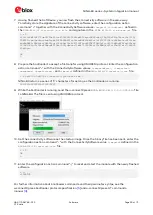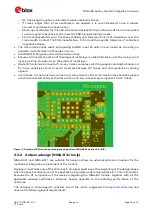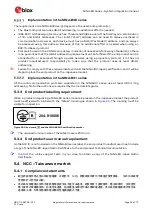
NINA-B3 series - System integration manual
UBX-17056748 - R13
Design-in
Page 43 of 72
C1-Public
3.9
Thermal guidelines
NINA-B3 series modules have been successfully tested from -40 °C to +85 °C. NINA-B3 series modules
are low power devices that generate only a small amount of heat during operation. A good grounding
should still be observed for temperature relief during high ambient temperatures.
3.10
ESD guidelines
The immunity of devices integrating NINA-B3 modules to Electrostatic Discharge (ESD) is part of the
Electromagnetic Compatibility (EMC) conformity, which is required for products bearing the CE
marking, compliant with the R&TTE Directive (99/5/EC), the EMC Directive (89/336/EEC) and the Low
Voltage Directive (73/23/EEC) issued by the Commission of the European Community.
Compliance with these directives implies conformity to the following European Norms for device ESD
immunity: ESD testing standard
CENELEC EN 61000-4-2
and the radio equipment standards
ETSI
EN 301 489-1
,
ETSI EN 301 489-7
,
ETSI EN 301 489-24
, the requirements of which are summarized
in
The ESD immunity test is performed at the enclosure port, defined by
ETSI EN 301 489-1
as the
physical boundary through which the electromagnetic field radiates. If the device implements an
integral antenna, the enclosure port is seen as all insulating and conductive surfaces housing the
device. If the device implements a removable antenna, the antenna port can be separated from the
enclosure port. The antenna port includes the antenna element and its interconnecting cable
surfaces.
The applicability of ESD immunity test to the whole device depends on the device classification as
defined by
ETSI EN 301 489-1
. Applicability of the ESD immunity test to the related device ports or
the related interconnecting cables to auxiliary equipment depends on device accessible interfaces
and manufacturer requirements, as defined by
ETSI EN 301 489-1
.
Contact discharges are performed at conductive surfaces, while air discharges are performed at
insulating surfaces. Indirect contact discharges are performed on the measurement setup horizontal
and vertical coupling planes as defined in
CENELEC EN 61000-4-2
.
☞
For the definition of integral antenna, removable antenna, antenna port, and the device
classification, refer to the
ETSI EN 301 489-1
. For the contact and air discharges definitions, refer
to
CENELEC EN 61000-4-2
.
Application
Category
Immunity level
All exposed surfaces of the radio equipment and ancillary
equipment in a representative configuration
Indirect Contact Discharge
±
8 kV
Table 10: Electromagnetic Compatibility ESD immunity requirements as defined by CENELEC EN 61000-4-2, ETSI EN 301
489-1, ETSI EN 301 489-7, ETSI EN 301 489-24
NINA-B3 is manufactured taking into account specific standards to minimize the occurrence of ESD
events; the highly automated process complies with IEC61340-5-1 (STM5.2-1999 Class M1 devices)
standard, and therefore the designer should implement proper measures to protect any pin that may
be exposed to the end user from ESD events.
Compliance with the standard protection level specified in EN61000-4-2 can be achieved by including
ESD protections in parallel to the line, close to areas accessible by the end user.
















































